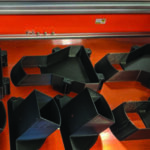CNH Industrial has released its first 3D printed spare parts, which are four components that can be used on buses and agricultural equipment. The capital goods company is integrating additive manufacturing into its supply chains to reduce material costs and increase product availability to customers.
Cost Savings That Scale
In the industrial manufacturing sector, parts can be very large and made of expensive composites, so conventional subtractive manufacturing methods like milling that cut material away from larger blocks can create huge costs in wasted material. A final part might use 30-60% of the original block of material it was cut from, but the manufacturer has to pay for the whole block. If you’re making only a few small bearings, the material waste cost might be only a few dollars, which is easy to absorb. But if you’re making a seven-foot part, there could be potentially thousands of dollars of material literally left on the floor every time one is made.
3D printing does away with 95% of those material waste costs, so it makes sense that global companies like CNH Industrial are looking to additive manufacturing to save money. 3D printing parts on demand not only reduces material costs but also inventory storage costs, and turnaround time is also shorter. When a customer has a broken down tractor and a crop that’s ready to harvest, a short turnaround time is critical. Their first 3D printed spare parts are plastic and they were put through stringent tests to ensure they meet CNH’s high standards; they are planning to print parts in metal as well.
Widespread Supply Chain Integration
CNH Industrial manufactures a wide range of goods, including tractors and agricultural machinery, earth-moving equipment, commercial trucks, buses, quarry and construction vehicles, firefighting vehicles, and engines and transmissions. That’s a lot of fingers in a lot of pies, and if each of those fingers starts operating a 3D printer, well, you get the idea.











